YAMAHA YZ250F 2005 Notices Demploi (in French)
Manufacturer: YAMAHA, Model Year: 2005, Model line: YZ250F, Model: YAMAHA YZ250F 2005Pages: 668, PDF Size: 15.74 MB
Page 611 of 668
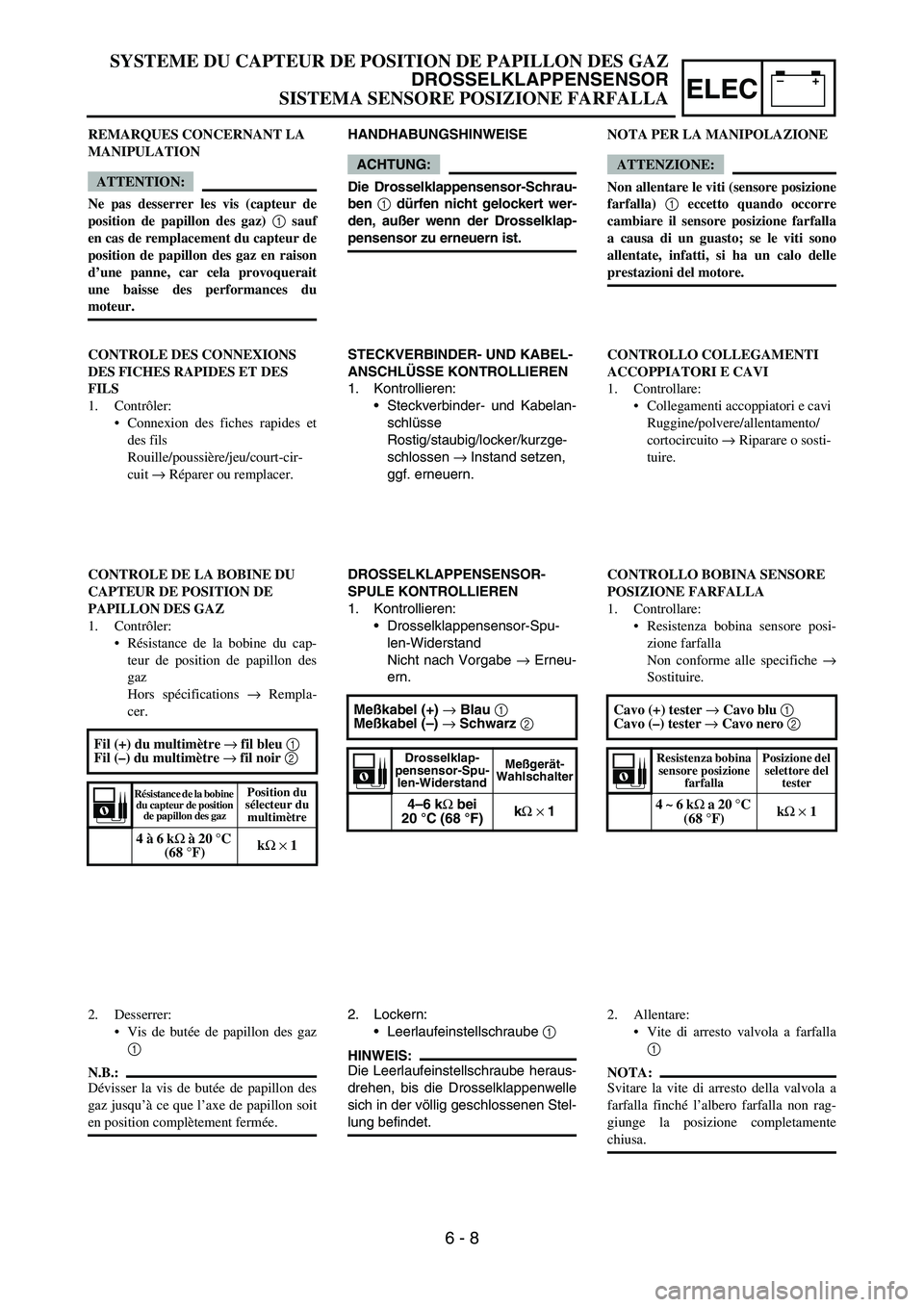
–+ELEC
HANDHABUNGSHINWEISE
ACHTUNG:
Die Drosselklappensensor-Schrau-
ben 1 dürfen nicht gelockert wer-
den, außer wenn der Drosselklap-
pensensor zu erneuern ist.
STECKVERBINDER- UND KABEL-
ANSCHLÜSSE KONTROLLIEREN
1. Kontrollieren:
Steckverbinder- und Kabelan-
schlüsse
Rostig/staubig/locker/kurzge-
schlossen → Instand setzen,
ggf. erneuern.
DROSSELKLAPPENSENSOR-
SPULE KONTROLLIEREN
1. Kontrollieren:
Drosselklappensensor-Spu-
len-Widerstand
Nicht nach Vorgabe → Erneu-
ern.
Meßkabel (+) → Blau 1
Meßkabel (–) → Schwarz 2
Drosselklap-
pensensor-Spu-
len-WiderstandMeßgerät-
Wahlschalter
4–6 kΩ bei
20 °C (68 °F)kΩ × 1
2. Lockern:
Leerlaufeinstellschraube 1
HINWEIS:
Die Leerlaufeinstellschraube heraus-
drehen, bis die Drosselklappenwelle
sich in der völlig geschlossenen Stel-
lung befindet. REMARQUES CONCERNANT LA
MANIPULATION
ATTENTION:
Ne pas desserrer les vis (capteur de
position de papillon des gaz) 1 sauf
en cas de remplacement du capteur de
position de papillon des gaz en raison
d’une panne, car cela provoquerait
une baisse des performances du
moteur.
CONTROLE DES CONNEXIONS
DES FICHES RAPIDES ET DES
FILS
1. Contrôler:
Connexion des fiches rapides et
des fils
Rouille/poussière/jeu/court-cir-
cuit → Réparer ou remplacer.
CONTROLE DE LA BOBINE DU
CAPTEUR DE POSITION DE
PAPILLON DES GAZ
1. Contrôler:
Résistance de la bobine du cap-
teur de position de papillon des
gaz
Hors spécifications → Rempla-
cer.
Fil (+) du multimètre → fil bleu 1
Fil (–) du multimètre → fil noir 2
Résistance de la bobine
du capteur de position
de papillon des gazPosition du
sélecteur du
multimètre
4 à 6 kΩ à 20 °C
(68 °F)kΩ × 1
2. Desserrer:
Vis de butée de papillon des gaz
1
N.B.:
Dévisser la vis de butée de papillon des
gaz jusqu’à ce que l’axe de papillon soit
en position complètement fermée.NOTA PER LA MANIPOLAZIONE
ATTENZIONE:
Non allentare le viti (sensore posizione
farfalla) 1 eccetto quando occorre
cambiare il sensore posizione farfalla
a causa di un guasto; se le viti sono
allentate, infatti, si ha un calo delle
prestazioni del motore.
CONTROLLO COLLEGAMENTI
ACCOPPIATORI E CAVI
1. Controllare:
Collegamenti accoppiatori e cavi
Ruggine/polvere/allentamento/
cortocircuito → Riparare o sosti-
tuire.
CONTROLLO BOBINA SENSORE
POSIZIONE FARFALLA
1. Controllare:
Resistenza bobina sensore posi-
zione farfalla
Non conforme alle specifiche →
Sostituire.
Cavo (+) tester → Cavo blu 1
Cavo (–) tester → Cavo nero 2
Resistenza bobina
sensore posizione
farfallaPosizione del
selettore del
tester
4 ~ 6 kΩ a 20 °C
(68 °F)kΩ × 1
2. Allentare:
Vite di arresto valvola a farfalla
1
NOTA:
Svitare la vite di arresto della valvola a
farfalla finché l’albero farfalla non rag-
giunge la posizione completamente
chiusa.
SYSTEME DU CAPTEUR DE POSITION DE PAPILLON DES GAZ
DROSSELKLAPPENSENSOR
SISTEMA SENSORE POSIZIONE FARFALLA
6 - 8
Page 612 of 668
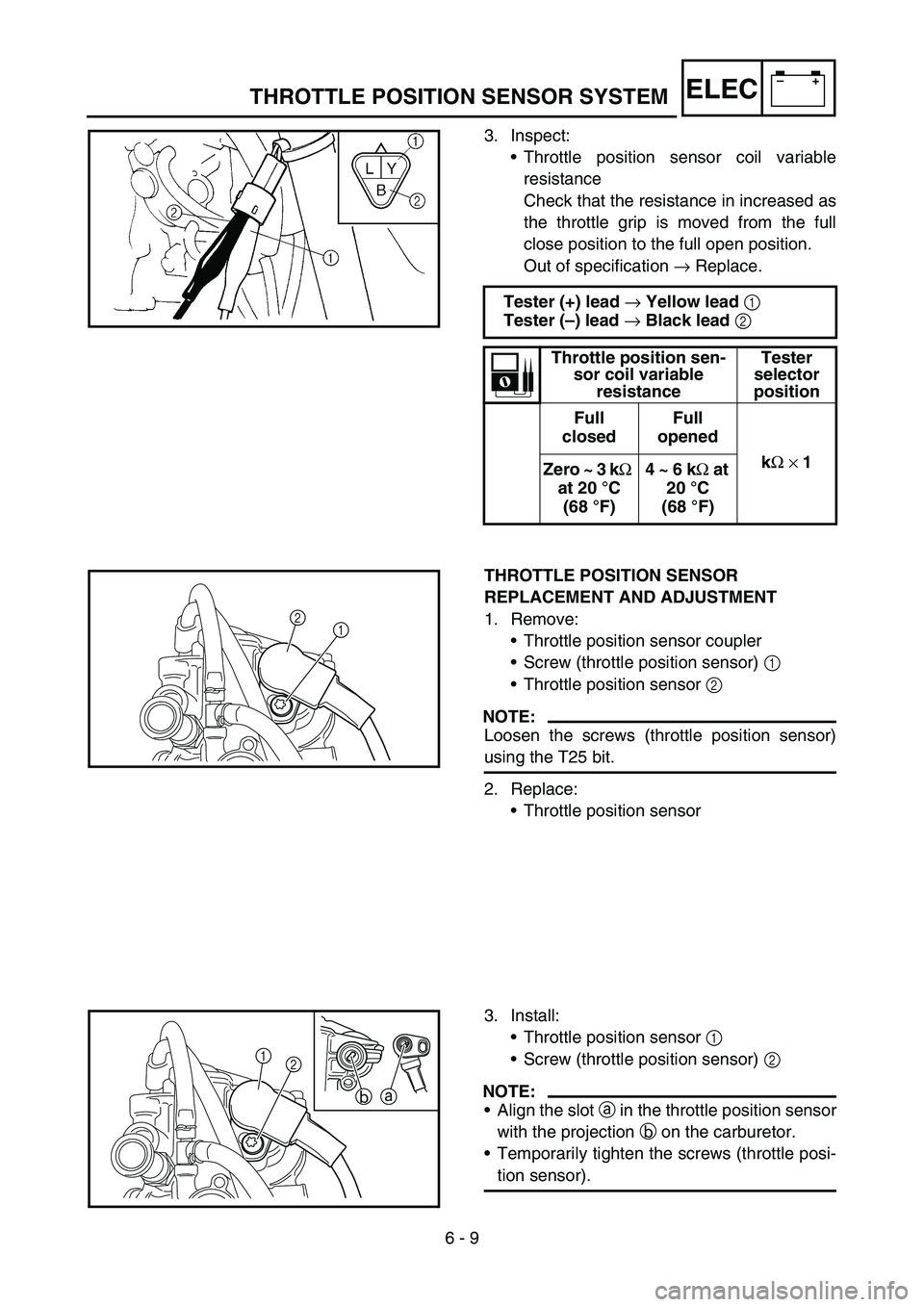
6 - 9
–+ELECTHROTTLE POSITION SENSOR SYSTEM
3. Inspect:
Throttle position sensor coil variable
resistance
Check that the resistance in increased as
the throttle grip is moved from the full
close position to the full open position.
Out of specification → Replace.
Tester (+) lead
→ Yellow lead
1
Tester (–) lead
→ Black lead
2
Throttle position sen-
sor coil variable
resistanceTester
selector
position
Full
closedFull
opened
k
Ω
× 1
Zero ~ 3 k
Ω
at 20 °C
(68°F)4 ~ 6 k
Ω at
20 °C
(68°F)
THROTTLE POSITION SENSOR
REPLACEMENT AND ADJUSTMENT
1. Remove:
Throttle position sensor coupler
Screw (throttle position sensor) 1
Throttle position sensor 2
NOTE:
Loosen the screws (throttle position sensor)
using the T25 bit.
2. Replace:
Throttle position sensor
12
3. Install:
Throttle position sensor 1
Screw (throttle position sensor) 2
NOTE:
Align the slot a in the throttle position sensor
with the projection b on the carburetor.
Temporarily tighten the screws (throttle posi-
tion sensor).
21
b
a
Page 613 of 668
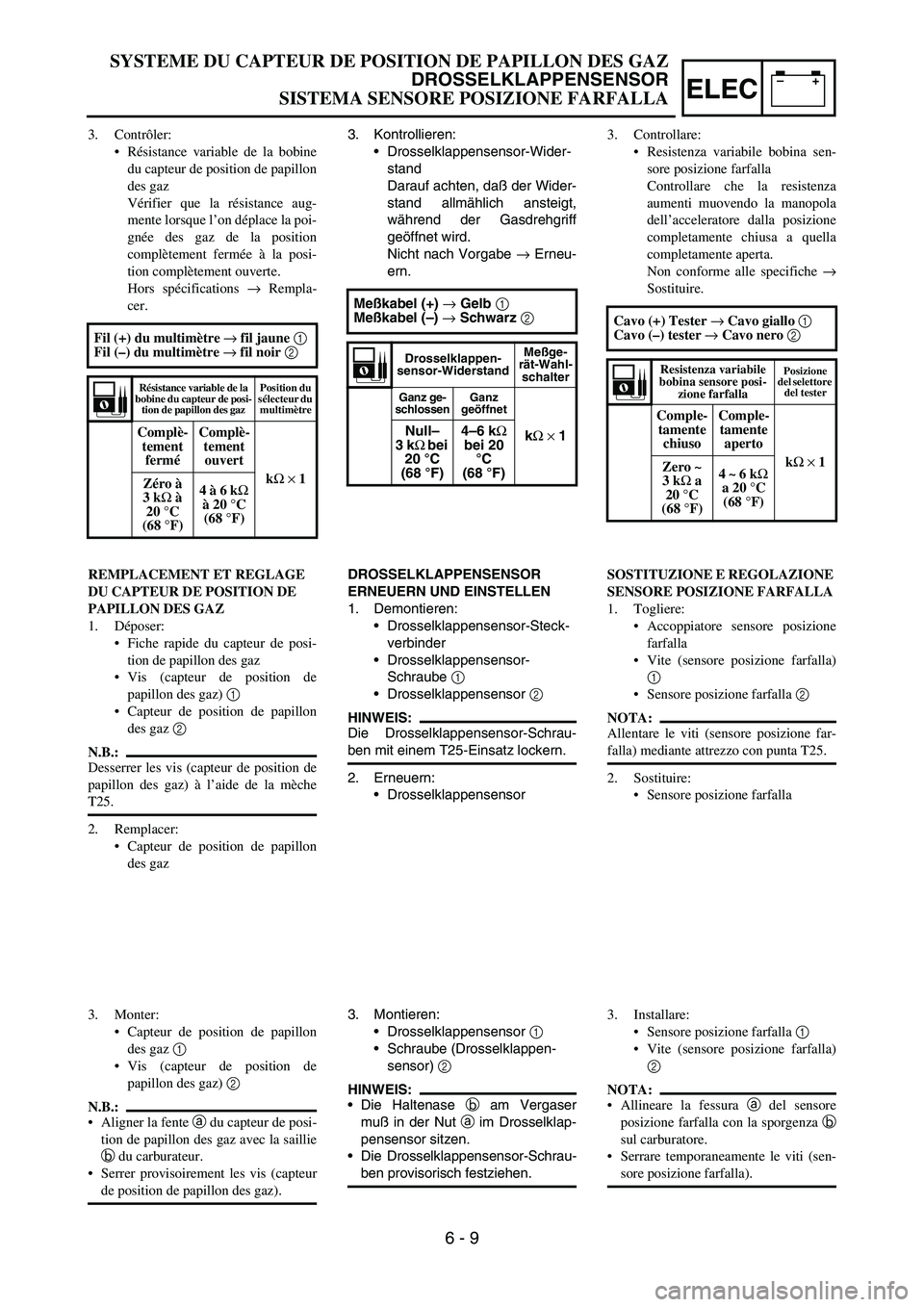
–+ELEC
3. Kontrollieren:
Drosselklappensensor-Wider-
stand
Darauf achten, daß der Wider-
stand allmählich ansteigt,
während der Gasdrehgriff
geöffnet wird.
Nicht nach Vorgabe → Erneu-
ern.
Meßkabel (+) → Gelb 1
Meßkabel (–) → Schwarz 2
Drosselklappen-
sensor-WiderstandMeßge-
rät-Wahl-
schalter
Ganz ge-
schlossenGanz
geöffnet
kΩ × 1 Null–
3kΩ bei
20°C
(68°F)4–6 kΩ
bei 20
°C
(68°F)
DROSSELKLAPPENSENSOR
ERNEUERN UND EINSTELLEN
1. Demontieren:
Drosselklappensensor-Steck-
verbinder
Drosselklappensensor-
Schraube 1
Drosselklappensensor 2
HINWEIS:
Die Drosselklappensensor-Schrau-
ben mit einem T25-Einsatz lockern.
2. Erneuern:
Drosselklappensensor
3. Montieren:
Drosselklappensensor 1
Schraube (Drosselklappen-
sensor) 2
HINWEIS:
Die Haltenase b am Vergaser
muß in der Nut a im Drosselklap-
pensensor sitzen.
Die Drosselklappensensor-Schrau-
ben provisorisch festziehen. 3. Contrôler:
Résistance variable de la bobine
du capteur de position de papillon
des gaz
Vérifier que la résistance aug-
mente lorsque l’on déplace la poi-
gnée des gaz de la position
complètement fermée à la posi-
tion complètement ouverte.
Hors spécifications → Rempla-
cer.
Fil (+) du multimètre → fil jaune 1
Fil (–) du multimètre → fil noir 2
Résistance variable de la
bobine du capteur de posi-
tion de papillon des gazPosition du
sélecteur du
multimètre
Complè-
tement
ferméComplè-
tement
ouvert
kΩ × 1
Zéro à
3kΩ à
20 °C
(68°F)4 à 6 kΩ
à 20 °C
(68°F)
REMPLACEMENT ET REGLAGE
DU CAPTEUR DE POSITION DE
PAPILLON DES GAZ
1. Déposer:
Fiche rapide du capteur de posi-
tion de papillon des gaz
Vis (capteur de position de
papillon des gaz) 1
Capteur de position de papillon
des gaz 2
N.B.:
Desserrer les vis (capteur de position de
papillon des gaz) à l’aide de la mèche
T25.
2. Remplacer:
Capteur de position de papillon
des gaz
3. Monter:
Capteur de position de papillon
des gaz 1
Vis (capteur de position de
papillon des gaz) 2
N.B.:
Aligner la fente a du capteur de posi-
tion de papillon des gaz avec la saillie
b du carburateur.
Serrer provisoirement les vis (capteur
de position de papillon des gaz).3. Controllare:
Resistenza variabile bobina sen-
sore posizione farfalla
Controllare che la resistenza
aumenti muovendo la manopola
dell’acceleratore dalla posizione
completamente chiusa a quella
completamente aperta.
Non conforme alle specifiche →
Sostituire.
Cavo (+) Tester → Cavo giallo 1
Cavo (–) tester → Cavo nero 2
Resistenza variabile
bobina sensore posi-
zione farfallaPosizione
del selettore
del tester
Comple-
tamente
chiusoComple-
tamente
aperto
kΩ × 1
Zero ~
3 kΩ a
20 °C
(68°F)4 ~ 6 kΩ
a 20 °C
(68°F)
SOSTITUZIONE E REGOLAZIONE
SENSORE POSIZIONE FARFALLA
1. Togliere:
Accoppiatore sensore posizione
farfalla
Vite (sensore posizione farfalla)
1
Sensore posizione farfalla 2
NOTA:
Allentare le viti (sensore posizione far-
falla) mediante attrezzo con punta T25.
2. Sostituire:
Sensore posizione farfalla
3. Installare:
Sensore posizione farfalla 1
Vite (sensore posizione farfalla)
2
NOTA:
Allineare la fessura a del sensore
posizione farfalla con la sporgenza b
sul carburatore.
Serrare temporaneamente le viti (sen-
sore posizione farfalla).
SYSTEME DU CAPTEUR DE POSITION DE PAPILLON DES GAZ
DROSSELKLAPPENSENSOR
SISTEMA SENSORE POSIZIONE FARFALLA
6 - 9
Page 614 of 668
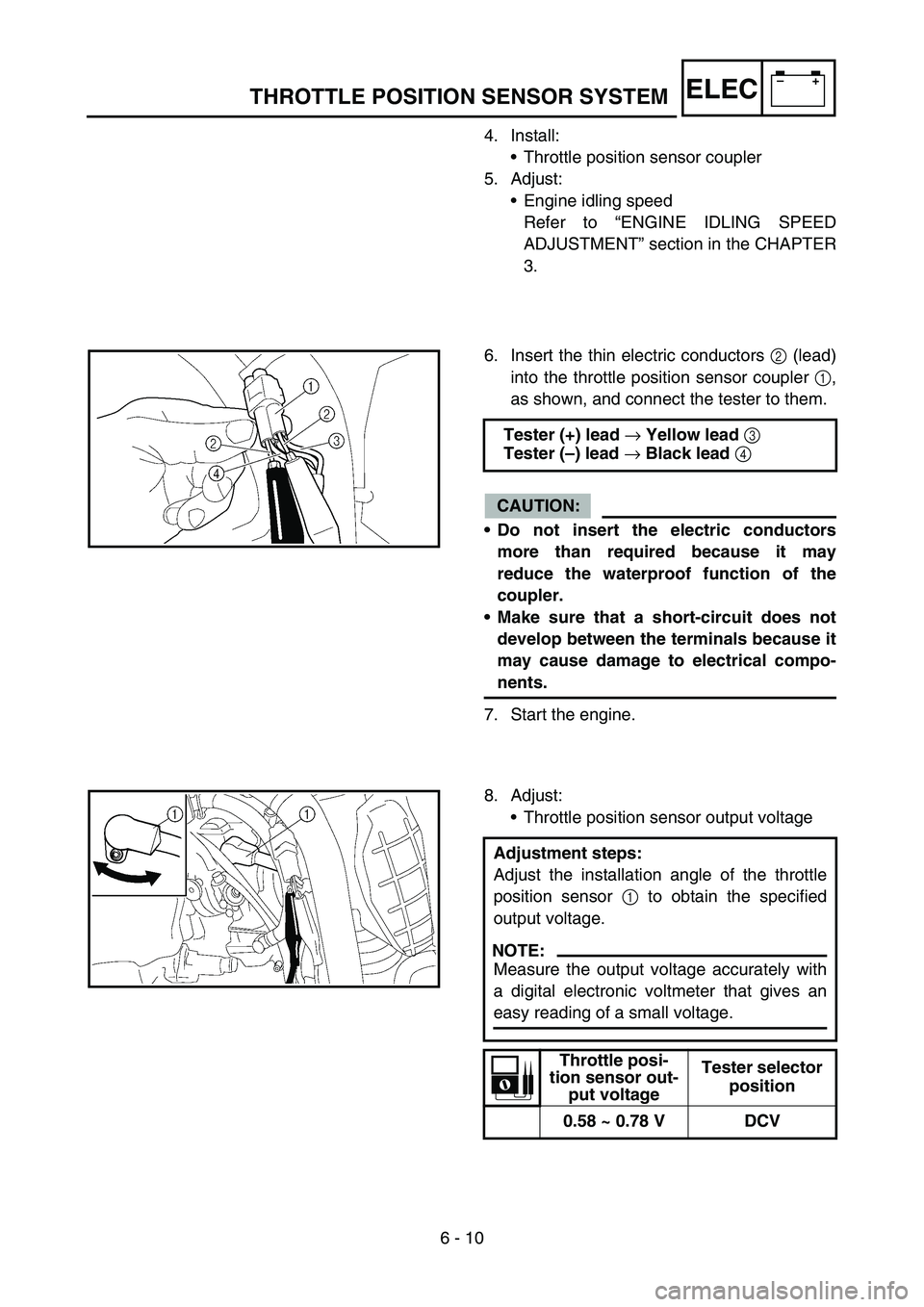
6 - 10
–+ELECTHROTTLE POSITION SENSOR SYSTEM
4. Install:
Throttle position sensor coupler
5. Adjust:
Engine idling speed
Refer to “ENGINE IDLING SPEED
ADJUSTMENT” section in the CHAPTER
3.
6. Insert the thin electric conductors 2 (lead)
into the throttle position sensor coupler 1,
as shown, and connect the tester to them.
CAUTION:
Do not insert the electric conductors
more than required because it may
reduce the waterproof function of the
coupler.
Make sure that a short-circuit does not
develop between the terminals because it
may cause damage to electrical compo-
nents.
7. Start the engine.Tester (+) lead
→ Yellow lead
3
Tester (–) lead
→ Black lead
4
8. Adjust:
Throttle position sensor output voltage
Adjustment steps:
Adjust the installation angle of the throttle
position sensor 1 to obtain the specified
output voltage.
NOTE:
Measure the output voltage accurately with
a digital electronic voltmeter that gives an
easy reading of a small voltage.
Throttle posi-
tion sensor out-
put voltageTester selector
position
0.58 ~ 0.78 V DCV
Page 615 of 668

–+ELEC
4. Montieren:
Drosselklappensensor-Steck-
verbinder
5. Einstellen:
Leerlaufdrehzahl
Siehe unter “LEERLAUF-
DREHZAHL EINSTELLEN” in
KAPITEL 3.
6. Dünne Leiter (Kabel) 2, wie in
der Abbildung gezeigt, in den
Drosselklappensensor-Steckver-
binder 1 stecken und das Meß-
gerät daran anschließen.
ACHTUNG:
Die elektrischen Leiter nicht tie-
fer als notwendig in den Steck-
verbinder stecken, um dessen
Wasserdichtigkeit nicht zu
beeinträchtigen.
Darauf achten, daß kein Kurz-
schluß vorliegt, um eine
Beschädigung der elektrischen
Anlage zu vermeiden.
7. Den Motor starten.Meßkabel (+) → Gelb 3
Meßkabel (–) → Schwarz 4
8. Einstellen:
Drosselklappensensor-Aus-
gangsspannung
Arbeitsvorgang:
Den Einbauwinkel des Drossel-
klappensensors 1 so einstellen,
daß die vorgeschriebene Aus-
gangsspannung anliegt.
HINWEIS:
Die Ausgangsspannung muß mit
einem präzisen Digitalmeßgerät
erfaßt werden.
Drosselklappen-
sensor-Aus-
gangsspannungMeßgerät-
Wahlschalter
0,58–0,78 V DCV
4. Monter:
Fiche rapide du capteur de posi-
tion de papillon des gaz
5. Régler:
Régime de ralenti du moteur
Se reporter à la section
“REGLAGE DU REGIME DE
RALENTI DU MOTEUR” au
CHAPITRE 3.
6. Introduire les fins conducteurs élec-
triques 2 (fils) dans la fiche rapide
du capteur de position de papillon
des gaz 1, comme illustré, et y rac-
corder le multimètre.
ATTENTION:
Ne pas enfoncer les conducteurs
électriques plus que nécessaire
parce que cela risque de réduire
l’étanchéité de la fiche rapide.
Veiller à ce qu’aucun court-circuit
ne se produise entre les bornes car
cela risque d’endommager les com-
posants électriques.
7. Mettre le moteur en marche.Fil (+) du multimètre → fil jaune 3
Fil (–) du multimètre → fil noir 4
8. Régler:
Tension de sortie du capteur de
position de papillon des gaz
Etapes du réglage:
Régler l’angle de montage du capteur
de position de papillon des gaz 1 de
manière à obtenir la tension de sortie
spécifiée.
N.B.:
Mesurer avec précision la tension de
sortie à l’aide d’un voltmètre électro-
nique permettant une lecture facile
des faibles tensions.
Tension de sortie du
capteur de position
de papillon des gazPosition du
sélecteur du
multimètre
0,58 à 0,78 V DCV
4. Installare:
Accoppiatore sensore posizione
farfalla
5. Regolare:
Regime del minimo
Fare riferimento al paragrafo
“REGOLAZIONE REGIME
DEL MINIMO” nel CAPITOLO
3.
6. Inserire i conduttori elettrici di pic-
cole dimensioni 2 (cavo)
nell’accoppiatore del sensore posi-
zione farfalla 1 come indicato in
figura e collegare il tester.
ATTENZIONE:
Non inserire i conduttori elettrici
più del necessario, perché ciò
potrebbe ridurre l’impermeabilità
dell’accoppiatore.
Assicurarsi che non si crei un corto-
circuito tra i terminali, perché ciò
potrebbe danneggiare i componenti
elettrici.
7. Avviare il motore.Cavo (+) tester → Cavo giallo 3
Cavo (–) tester → Cavo nero 4
8. Regolare:
Tensione in uscita sensore posi-
zione farfalla
Operazioni per la regolazione:
Regolare l’angolo di installazione del
sensore posizione farfalla 1 fino a
raggiungere la tensione in uscita indi-
cata.
NOTA:
Misurare con precisione la tensione
in uscita con l’aiuto di un voltmetro
digitale, che consente di leggere
facilmente anche le tensioni ridotte.
Tensione in
uscita sensore
posizione farfallaPosizione del
selettore del
tester
0,58 ~ 0,78 V DCV
SYSTEME DU CAPTEUR DE POSITION DE PAPILLON DES GAZ
DROSSELKLAPPENSENSOR
SISTEMA SENSORE POSIZIONE FARFALLA
6 - 10
Page 616 of 668

6 - 11
–+ELEC
9. Tighten:
Screw (throttle position sensor) 1
NOTE:
Tighten the screws (throttle position sensor)
using the T25 bit.
1
10. Stop the engine.
THROTTLE POSITION SENSOR INPUT
VOLTAGE INSPECTION
1. Disconnect the throttle position sensor cou-
pler.
2. Start the engine.
3. Inspect:
Throttle position sensor input voltage
Out of specification → Replace the CDI
unit.
Tester (+) lead → Blue lead 1
Tester (–) lead → Black/Blue lead 2
Throttle posi-
tion sensor
input voltageTester selector
position
4 ~ 6 V DCV-20
THROTTLE POSITION SENSOR SYSTEM
Page 617 of 668

–+ELEC
9. Festziehen:
Drosselklappensensor-
Schraube 1
HINWEIS:
Die Drosselklappensensor-Schrau-
ben mit einem T25-Einsatz festzie-
hen.
10. Den Motor abstellen.
DROSSELKLAPPENSENSOR-
EINGANGSSPANNUNG
KONTROLLIEREN
1. Den Drosselklappensensor-
Steckverbinder lösen.
2. Den Motor starten.
3. Kontrollieren:
Drosselklappensensor-Ein-
gangsspannung
Nicht nach Vorgabe → Zünd-
box erneuern.
Meßkabel (+) → Blau 1
Meßkabel (–) → Schwarz/Blau 2
Drosselklappen-
sensor-Ein-
gangsspannungMeßgerät-
Wahlschalter
4–6 V DCV-20
9. Serrer:
Vis (capteur de position de
papillon des gaz) 1
N.B.:
Serrer les vis (capteur de position de
papillon des gaz) à l’aide de la mèche
T25.
10. Arrêter le moteur.
CONTROLE DE LA TENSION
D’ENTREE DU CAPTEUR DE
POSITION DE PAPILLON DES
GAZ
1. Débrancher la fiche rapide du cap-
teur de position de papillon des gaz
2. Mettre le moteur en marche.
3. Contrôler:
Tension d’entrée du capteur de
position de papillon des gaz
Hors spécifications → Remplacer
le boîtier CDI.
Fil (+) du multimètre → fil bleu 1
Fil (–) du multimètre →
fil noir/bleu 2
Tension d’entrée du
capteur de position
de papillon des gazPosition du
sélecteur du
multimètre
4 à 6 V DCV-20
9. Serrare:
Vite (sensore posizione farfalla)
1
NOTA:
Serrare le viti (sensore posizione far-
falla) mediante attrezzo con punta T25.
10. Arrestare il motore.
CONTROLLO TENSIONE IN
ENTRATA SENSORE POSIZIONE
FARFALLA
1. Scollegare l’accoppiatore del sen-
sore posizione farfalla.
2. Avviare il motore.
3. Controllare:
Tensione in entrata sensore posi-
zione farfalla
Non conforme alle specifiche →
Sostituire l’unità CDI.
Cavo (+) tester → Cavo blu 1
Cavo (–) tester → Cavo nero/blu 2
Tensione in
entrata sensore
posizione farfallaPosizione del
selettore del
tester
4 ~ 6 V DCV-20
SYSTEME DU CAPTEUR DE POSITION DE PAPILLON DES GAZ
DROSSELKLAPPENSENSOR
SISTEMA SENSORE POSIZIONE FARFALLA
6 - 11
Page 618 of 668
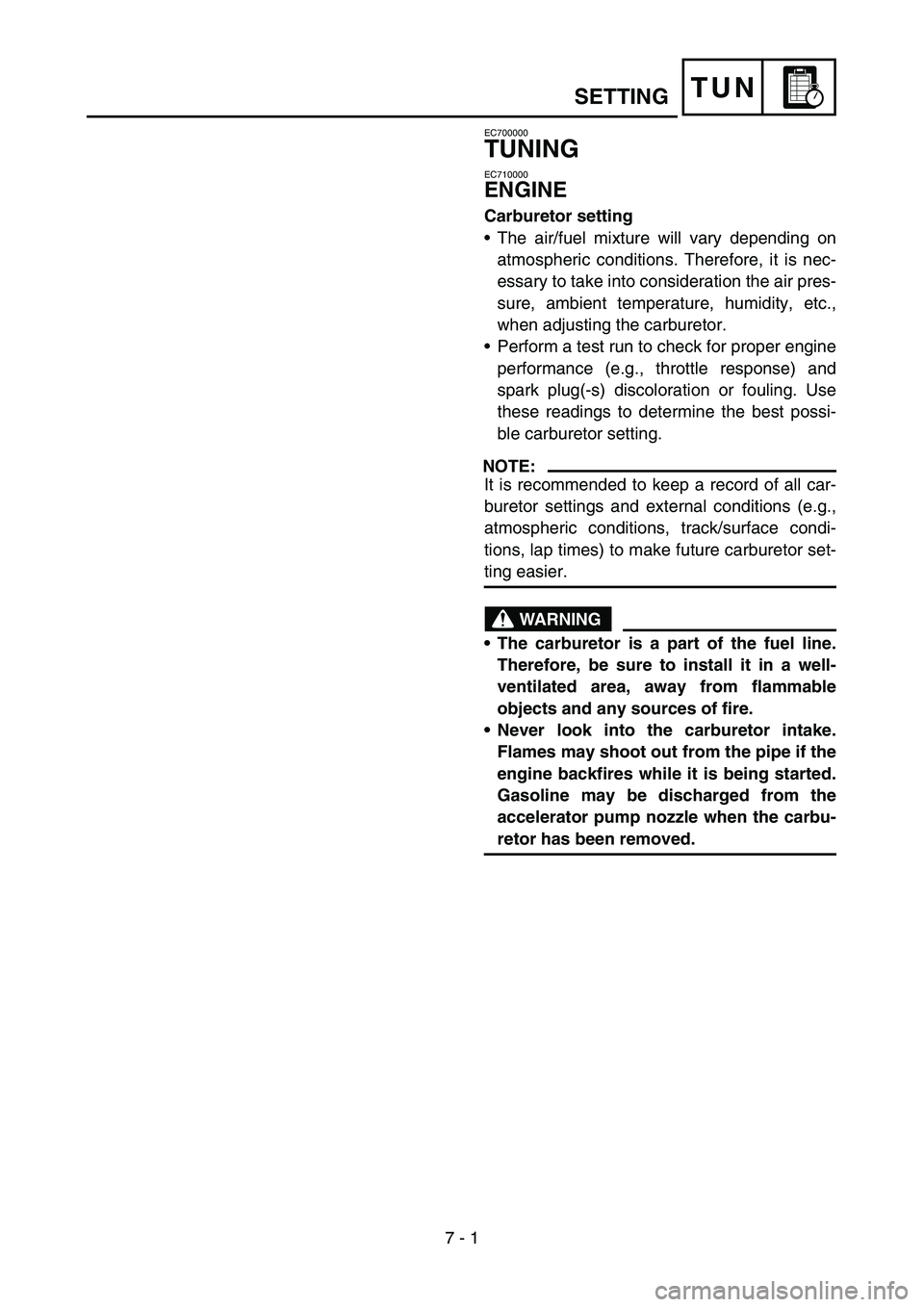
7 - 1
TUN
EC700000
TUNING
EC710000
ENGINE
Carburetor setting
The air/fuel mixture will vary depending on
atmospheric conditions. Therefore, it is nec-
essary to take into consideration the air pres-
sure, ambient temperature, humidity, etc.,
when adjusting the carburetor.
Perform a test run to check for proper engine
performance (e.g., throttle response) and
spark plug(-s) discoloration or fouling. Use
these readings to determine the best possi-
ble carburetor setting.
NOTE:
It is recommended to keep a record of all car-
buretor settings and external conditions (e.g.,
atmospheric conditions, track/surface condi-
tions, lap times) to make future carburetor set-
ting easier.
WARNING
The carburetor is a part of the fuel line.
Therefore, be sure to install it in a well-
ventilated area, away from flammable
objects and any sources of fire.
Never look into the carburetor intake.
Flames may shoot out from the pipe if the
engine backfires while it is being started.
Gasoline may be discharged from the
accelerator pump nozzle when the carbu-
retor has been removed.
SETTING
Page 619 of 668

TUN
ABSTIMMUNG
MOTOR
Vergaser-Abstimmung
Das Gemisch hängt u. a. von den
atmosphärischen Bedingungen ab.
Luftdruck, -temperatur und -feuch-
tigkeit sind Faktoren, die bei der
Vergaser-Abstimmung mit in
Betracht gezogen werden müssen.
Die Leistung und das Ansprech-
verhalten des Motors sowie der
Zustand der Kerze lassen sich am
besten im einem Testlauf prüfen.
Anhand dieser Ergebnisse kann
der Vergaser optimal eingestellt
werden.
HINWEIS:
Es empfiehlt sich, die jeweiligen
Umstände (atmosphärische Bedin-
gungen, Fahrbahnzustand, Anzahl
Runden usw.) und die entsprechen-
den Vergaser-Einstellungen zwecks
späterer Bezugnahme aufzuzeich-
nen.
WARNUNG
Der Vergaser ist ein Bestandteil
des Kraftstoffsystems. Bei
Arbeiten daher stets auf eine
gute Belüftung sorgen und Feu-
erquellen sowie entzündliche
Stoffe fernhalten.
Niemals in den Vergasereinlaß
hineinblikken. Beim Starten des
Motors könnten Flammen rück-
schlagen. Auch bei ausgebau-
tem Vergaser könnte Benzin aus
der Beschleunigungspumpe
entweichen.
MISE AU POINT
MOTEUR
Réglage du carburateur
Le mélange air/carburant varie en
fonction des conditions atmosphéri-
ques. Il est donc nécessaire de tenir
compte de la pression de l’air, de la
température ambiante, de l’humidité,
etc., pour le réglage du carburateur.
Effectuer un essai de conduite pour
contrôler les performances du moteur
(par ex. la réponse du moteur) et l’état
des bougies (décoloration ou encrasse-
ment). Utiliser les valeurs obtenues
pour effectuer le meilleur réglage pos-
sible du carburateur.
N.B.:
Il est recommandé de conserver un enre-
gistrement de tous les réglages du carbu-
rateur et des conditions extérieures
(conditions atmosphériques, conditions
de la piste/de la surface, temps intermé-
diaire) pour faciliter les réglages ulté-
rieurs du carburateur.
AVERTISSEMENT
Le carburateur fait partie du circuit
d’alimentation. Par conséquent,
veiller à effectuer le montage dans
un endroit bien aéré, à l’écart de
tout objet inflammable ou de toute
source d’incendie.
Ne jamais regarder dans l’admis-
sion du carburateur. Des flammes
peuvent surgir du tuyau en cas de
retour de flamme du moteur au
démarrage. De l’essence peut
s’écouler de l’injecteur de la pompe
de reprise lorsque le carburateur a
été déposé.
MESSA A PUNTO
MOTORE
Impostazione carburatore
La miscela aria/carburante varia a
seconda delle condizioni atmosferi-
che. Di conseguenza, durante la rego-
lazione del carburatore è necessario
tenere in considerazione la pressione
dell’aria, la temperatura
dell’ambiente, l’umidità ecc.
Eseguire un giro di prova per control-
lare l’efficienza del motore (ad es. la
reattività dell’acceleratore) e la pre-
senza di macchie o incrostazioni sulla/
e candela/e. Utilizzare queste letture
per determinare la migliore imposta-
zione possibile del carburatore.
NOTA:
Si consiglia di prendere nota di tutte le
impostazioni del carburatore e delle con-
dizioni esterne (ad es. condizioni atmo-
sferiche, condizioni del percorso e della
superficie, tempi per ogni giro) per sem-
plificare le successive impostazioni del
carburatore.
AVVERTENZA
Il carburatore fa parte del circuito
del carburante. Di conseguenza,
assicurarsi di installarlo in un
ambiente ben ventilato, lontano da
sostanze infiammabili e da ogni
fonte di fuoco.
Non guardare mai all’interno
dell’aspirazione del carburatore. Se
durante l’avvio il motore ha un
ritorno di fiamma, potrebbero svi-
lupparsi fiamme dal tubo. Quando
si toglie il carburatore, l’ugello della
pompa acceleratore può scaricare
benzina.
REGLAGE
EINSTELLUNG
REGISTRAZIONE
7 - 1
7
Page 620 of 668

7 - 2
TUN
CAUTION:
The carburetor is extremely sensitive to
foreign matter (dirt, sand, water, etc.).
During installation, do not allow foreign
matter to get into the carburetor.
Always handle the carburetor and its
components carefully. Even slight
scratches, bends or damage to carburetor
parts may prevent the carburetor from
functioning correctly. Carefully perform
all servicing with the appropriate tools
and without applying excessive force.
When the engine is stopped or when
riding at no load, do not open and close
the throttle unnecessarily. Otherwise, too
much fuel may be discharged, starting
may become difficult or the engine may
not run well.
After installing the carburetor, check that
the throttle operates correctly and opens
and closes smoothly.
Atmospheric conditions and carburetor
settings
The air density (i.e., concentration of oxygen
in the air) determines the richness or lean-
ness of the air/fuel mixture. Therefore, refer
to the above table for mixture settings.
That is:
Higher temperature expands the air with its
resultant reduced density.
Higher humidity reduces the amount of oxy-
gen in the air by so much of the water vapor
in the same air.
Lower atmospheric pressure (at a high alti-
tude) reduces the density of the air.
Air temp. HumidityAir
pressure
(altitude)Mixture Setting
High High Low (high) Richer Leaner
Low Low High (low) Leaner Richer
SETTING